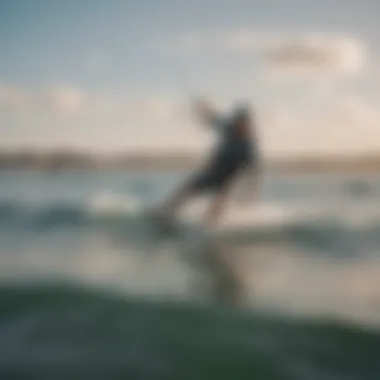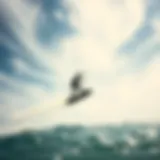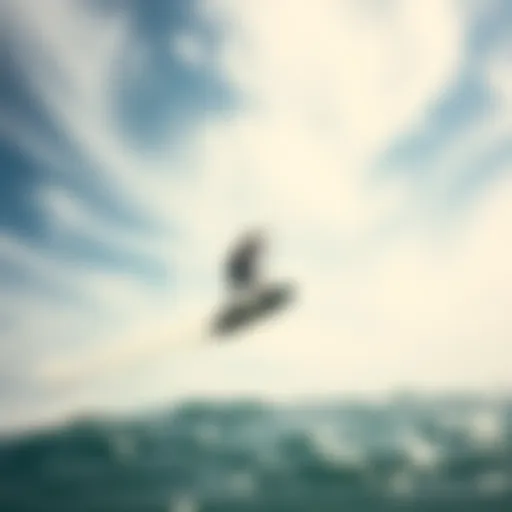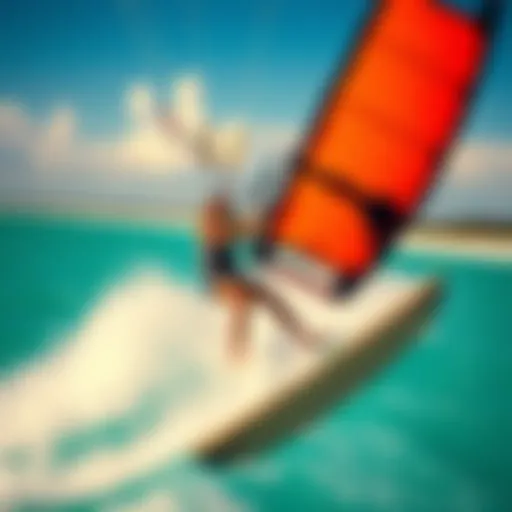Discover the Essential Kitesurfing Shop Guide


Intro
Kitesurfing has evolved into more than just a thrilling water sport; it is a way of life for many. A kitesurfing shop is often the first portal for enthusiasts diving into this exhilarating world. These shops are not mere commercial endeavors—they serve as hubs of knowledge, community, and innovation. Understanding what kitesurfing shops offer can enrich your experience immensely.
Whether you are a novice stepping onto the board for the first time, or a seasoned kitesurfer looking to refine your skills, the kitesurfing shop stands ready to meet your needs. The equipment has come a long way since its beginnings, and so too have the shops that cater to this dynamic sport. From in-depth gear reviews to advice on techniques, this guide aims to illuminate the aspects of kitesurfing shops crucial for your journey.
Let's delve into the details.
Gear Insights
Latest Gear Reviews
Kitesurfing gear is not just about aesthetics; it plays a critical role in performance. Each year, advancements in materials and design make waves in the industry, sometimes literally! When selecting gear, one should consider not just the style, but also the practicality and durability of the equipment.
For instance, brands like Duotone and North Kiteboarding continuously push the envelope. Their new kite models often incorporate lightweight materials without skimming on strength, allowing for better control and agility on the water.
Some recent reviews highlight the Duotone Evo 2023, praised for its versatility and user-friendly design. Alternatively, the North Atmos kite has been recognized for its lightweight frames that enable impressive lift during stunts. Each of these products has its niche, so understanding specific performance characteristics is essential.
Essential Gear for Beginners
When you're starting out, the array of kites, boards, and accessories might feel overwhelming. However, a few pieces are non-negotiable for anyone taking their first steps into this sport.
- Kite: Choosing a beginner kite is crucial. Look for something like the Airush Lift, which provides stability, making your initial rides smoother.
- Board: An entry-level twin-tip board, such as the Naish Motion, offers ease of use and is forgiving in rough waters.
- Harness: Don’t underestimate the importance of a comfortable harness. The ION Riot has a solid reputation for its fit and functionality.
It’s paramount to invest in quality safety gear as well—helmets and impact vests enhance protection while you find your sea legs.
Techniques and Tips
Advanced Tricks and Techniques
For the more experienced kiteboarders looking to up their game, mastering tricks such as the handle pass or the backloop can elevate your kiteboarding experience. These moves may seem daunting but breaking them down into smaller, manageable steps is key. Watching tutorials and practicing on flat water can be beneficial.
Safety Practices for Kiteboarders
While the thrill of kitesurfing draws many to the water, practicing safety should always be a top priority. Here are some must-follow safety tips:
- Always check wind conditions before launching your kite.
- Be aware of local regulations and designated kite zones.
- Always wear a quick-release harness and keep your safety leash attached to your kite.
- Practice self-rescue techniques regularly, ideally during calmer days.
"A well-prepared kiteboarder is one who enjoys every ride while keeping safety in mind."
Ending
The journey into kitesurfing can be both exciting and daunting. However, ensuring you have the right gear, learning techniques, and remaining vigilant about safety can make all the difference. This guide provides insights into what you will find in kitesurfing shops and how to harness this information to enhance your kiteboarding experience. Embrace the adventure and ride the waves with confidence!
Preface to Kitesurfing Shops
Kitesurfing shops play a crucial role in the kiteboarding community. Not just simple stores, these establishments serve as a nexus where passion meets product. They are vibrant hubs where enthusiasts gather, exchange tips, and gear up for adventure on the water. This section underscores the significance of kitesurfing shops, highlighting their multifaceted benefits and considerations for both new and experienced kiteboarders.
The Role of Shops in Kitesurfing
When one thinks of a kitesurfing shop, images of colorful kites and sleek boards likely come to mind. However, the essence of these shops extends far beyond merely selling equipment. They embody a spirit of community and collective knowledge that is indispensable.
- Expert Guidance: Kitesurfing shops are often staffed by individuals who share a deep-rooted passion for the sport. These knowledgeable employees can provide personalized recommendations tailored to a customer’s skill level and local conditions. This guidance helps ensure that enthusiasts choose gear that fits their style and needs, avoiding the pitfalls of making uninformed purchases.
- Test Before You Buy: Many shops offer demo equipment that allows customers to try out gear before committing to a purchase. This is especially key in kitesurfing, where the right choice can significantly influence a rider's performance and enjoyment.
- Post-Purchase Support: A purchase rarely ends with the transaction. Shops often provide after-sales services, including maintenance tips and repair advice, which are critical for ensuring the longevity and safety of kitesurfing gear.
Brief History of Kitesurfing Retail


Kitesurfing itself has undergone significant evolution since its inception in the late 20th century. In this light, kitesurfing shops have also transformed, reflecting changes in the sport and market demands.
Initially, gear was hard to come by. Early enthusiasts often crafted their own kites from makeshift materials, relying on trial and error. The first mainstream kitesurfing shops emerged as the sport gained traction, allowing more people to access quality equipment. These shops played a pivotal role in standardizing designs and safety protocols, making the sport safer and more appealing.
As kitesurfing grew, so did the variety of shops. Some specialized in premium gear, others focused on local communities, offering a tailored selection that reflected regional conditions and common preferences. Today, the integration of e-commerce has also reshaped the retail landscape for kitesurfing enthusiasts. Now, one can easily browse extensive options online while still reaping the benefits of local expertise and connections.
In summary, kitesurfing shops embody a rich history and continue to evolve in response to both community needs and market trends. They serve as vital pillars for both seasoned riders and newcomers, providing support, gear, and a sense of belonging in the captivating world of kiteboarding.
Types of Kitesurfing Gear Available
The realm of kitesurfing is not just about thrilling rides over waves; it’s significantly influenced by the gear you choose. Without the right equipment, even the most seasoned rider can face challenges on the water. Understanding the various categories and types of kitesurfing gear, from kites to safety equipment, is essential in making informed choices.
A well-equipped kitesurfer not only elevates personal performance but also ensures safety while enjoying the sport. Each piece of gear comes with unique benefits and specifications, catering to different skill levels, local conditions, and personal preferences. In this section, we will delve into four key areas of kitesurfing gear: kites, boards, harnesses, and safety equipment, dissecting their roles and importance in enhancing the overall kitesurfing experience.
Kites: An Overview
When we discuss kites in kitesurfing, we refer to the heart of the sport. Kites act as your lifeline to the wind, capturing it to propel you across the water. Traditionally, kites come in various shapes and sizes, each tailored for specific riding styles and wind conditions. Here’s what to consider:
- Types of Kites: There are two primary types: C-kites and bow kites. C-kites offer direct feedback and power control, preferred by freestyle enthusiasts. Bow kites, on the other hand, are more beginner-friendly, allowing easy relaunching and better control in light winds.
- Size Matters: The size of the kite is another pivotal element. Larger kites are fantastic for lighter winds, whereas smaller kites shine in higher wind conditions. Getting the right size can make a world of difference in your comfort and performance.
- Material and Construction: Pay attention to the materials used. Kites made from durable fabrics can withstand harsh conditions and last longer, which can be a cost saver in the long run.
Boards and Their Varieties
Selecting the right board is akin to choosing your steed. The board helps determine your riding style, speed, and overall maneuverability on the waves. Here are key types of boards:
- Directional Boards: Often used for wave riding, these boards excel in navigation. They have a surfboard-like design and allow for versatile turns, making them suitable for those looking to carve into waves.
- Twintip Boards: Perfect for all-around use and great for riders starting out. They are symmetrical and work well whether you're going heel-side or toe-side. Additionally, they perform well with jumps.
- Freestyle Boards: They are characterized by a softer flex and flatter shape, helping in jumps and tricks. If you’re into learning flashy moves, consider investing in this type.
Harnesses: Choices and Considerations
Harnesses are like the unsung heroes of kitesurfing gear. They connect you to the kite, taking the strain off your arms. So, what should you consider when selecting a harness?
- Types of Harnesses: There are two main types: waist harnesses and seat harnesses. Waist harnesses offer more freedom of movement and are preferable for tricks, while seat harnesses provide better back support and are typically recommended for beginners.
- Fit and Comfort: Finding a harness that fits well is crucial; it should feel snug without being restrictive. Remember, a comfortable harness makes a significant difference when you’re out on the water for extended periods.
- Material Quality: As with kites, pay attention to material quality. Neoprene-lined harnesses often enhance comfort, while well-stitched seams contribute to durability.
Safety Equipment: Essential Additions
Safety gear is not to be taken lightly. When you’re soaring over waves, knowing you’re well-protected allows you to enjoy the sport more fully. Key safety equipment includes:
- Impact Vests: These provide buoyancy and additional protection against falling. They come in different designs; some include flotation devices while others focus more on padding.
- Helmets: Protects your head from accidental impacts or in case of falls. Helmets have come a long way and now are surprisingly lightweight and breathable.
- Leashes: Connecting your kite to yourself or your board is essential to avoid losing your gear in case of an unexpected tumble. Ensure your leash is of a high quality to prevent breakage.
"While gear can enhance your experience, it’s your skills and decisions on the water that ultimately matter."
Understanding these elements can make a significant difference in your kitesurfing journey, allowing you to enjoy the sport to the fullest, free from unnecessary complications.
Choosing the Right Equipment
When you're stepping into the world of kitesurfing, choosing the right equipment is crucial. It's not just about winging it with any old gear; the right selection can make all the difference in your experience on the water. This section will break down some essential aspects to consider as you embark on this thrilling journey, ensuring you’re well-prepared to tackle the waves.
Identifying Skill Levels
Understanding your own ability level is one of the first steps in selecting the right kitesurfing equipment. If you’re a novice, you might feel tempted to jump straight to advanced gear, but that can lead to a rocky start.
- Beginner: Look for a larger kite with a stable design. Its size helps produce enough lift, making it easier to learn the ropes. A board with more volume can also provide better buoyancy.
- Intermediate: You might want to shift to a kite with a bit more performance. Focus on a balance between agility and stability to enhance your skills.
- Advanced: Now, your choice should depend on your preferred styles, like freestyle or wave riding. Each discipline has specific equipment requirements that cater to performance and control.
This self-awareness aids in avoiding unnecessary frustrations and accidents, allowing for a smoother transition as you grow in the sport.
Assessing Local Conditions
Understanding the environment where you’ll be kitesurfing is vital. Each location comes with its own set of elements like wind patterns, water depth, and wave size. Knowing these factors allows you to choose gear that’s tailored for the conditions you'll be facing.


- Wind Strength: If it’s typically gusty, you might want a more versatile kite. If the wind is smooth, go for a kite that maximizes performance.
- Water Types: Choppy waters require different board designs than flat waters. A more flexible board might help with control in rough conditions.
- Weather Patterns: Keeping an eye on seasonal changes can inform decisions on sturdiness or portability of your gear.
Having a grasp on these factors can greatly enhance your sessions and keep you safe out there.
Budgeting for Your Purchase
Budget is always a significant factor when diving into any sport, and kitesurfing is no exception. It’s easy to get caught up in the latest trends and shiny new equipment, but being financially savvy is key.
When planning your budget:
- Set Priorities: Decide what you need immediately versus what you can hold off on. A quality kite and board are essentials; accessories can often wait.
- Consider Second-Hand Gear: Sometimes, slightly used equipment can serve beginners well, as they transition into the sport.
- Quality Over Quantity: It might be tempting to buy everything at once. Instead, invest in fewer, high-quality items that will perform better over time.
Ultimately, being smart about spending means you can enjoy more time riding, rather than stressing over costs.
"Choosing the right equipment isn’t just about what looks cool or what’s trending; it’s about what works for you and makes your experience enjoyable."
Taking these aspects into account will aid you in making knowledgeable decisions, contributing to your growth and satisfaction within the kitesurfing community.
Retail Trends and Innovations
The world of kitesurfing shops is not static; it ebbs and flows with the tide of consumer preferences, technology, and global influences. Keeping one's finger on the pulse of retail trends and innovations is crucial for making informed purchasing decisions and understanding how these shops serve the kitesurfing community. This section dives into the essential dynamics shaping the kitesurfing retail environment, emphasizing the significance of emerging online retail, sustainable practices in product offerings, and advancements in gear technology. Exploring these elements can greatly enhance the experience of hobbyists, instructors, and adventurous travelers alike.
Emergence of Online Retail
The rise of online retail presents a paradigm shift in how customers interact with kitesurfing shops. More than just a trend, this shift addresses convenience and accessibility, enabling enthusiasts to browse an extensive selection of gear without geographical limitations. One can compare prices from the comfort of one’s living room, ensuring the best deal before hitting the waves. Retailers have begun to embrace e-commerce platforms, allowing them to showcase their offerings visually. Websites are designed not just for sales but also to educate consumers about the equipment they might need. Furthermore, many shops now incorporate virtual consultations, helping customers make tailored decisions based on their unique skills and local conditions.
However, it’s not without its pitfalls. One drawback is the inability to physically inspect the gear before purchase. Users might find themselves pondering over fitting harnesses or the right kite size, unsure whether an online set-up truly meets their needs. Still, reputable shops counter this by offering easy return policies and detailed descriptions with customer reviews that lend credibility to their products.
Sustainability in Kitesurfing Products
As environmental concerns intensify globally, sustainability has become a priority for many businesses, including kitesurfing shops. Consumers progressively favor brands that demonstrate responsible sourcing and manufacturing processes. By opting for eco-friendly materials and production practices, retailers can appeal to a growing demographic of conscious buyers who prioritize sustainability over mere trends. For example, some manufacturers now produce kiteboards made from recycled materials while maintaining performance standards.
This commitment to environmental stewardship extends beyond product offerings. Kitesurfing shops are increasingly getting involved in local cleanup efforts, like organizing beach clean-up days or collaborating with environmental organizations. The sense of community created through these initiatives not only draws customers in but also fosters brand loyalty that can be captivating.
Technological Advances in Gear Design
As the sport evolves, so too does the technology behind kitesurfing gear. The latest innovations integrate cutting-edge materials and design techniques to enhance performance and safety. For instance, advancements in aerodynamics and lightweight composites contribute to kites that fly higher and require less effort to maneuver. The adoption of smart technology, such as GPS tracking devices, has started to make an entry into the kitesurfing world, providing data for riders wanting to monitor their performance more precisely.
Equally noteworthy is the emergence of modular gear, allowing riders to interchange components in their setups based on conditions and skill levels. Adjustable boards and customizable kites can greatly improve the kitesurfing experience, catering to a wider range of skill levels and preferences. This means that whether you’re a rookie finding your footing or a seasoned pro looking to diversify your gear, there’s something for everyone in the increasingly sophisticated realm of kitesurfing equipment.
The shift toward sophisticated gear doesn’t just showcase innovation; it invites both customization and creativity. Riders can now express their style while navigating the waves, merging function with fashion.
In summary, the exploration of retail trends and innovations within kitesurfing shops reveals a vibrant landscape filled with evolving challenges and novel opportunities. As shops adapt to the demands of an ever-growing community, staying abreast of these trends can empower kiteboarders to make informed choices anchored in both performance and environmental consideration. In an era where digital interaction reigns and sustainability takes precedence, understanding these components becomes fundamental for both enthusiasts and retailers.
The Community Aspect of Kitesurfing Shops
In the world of kitesurfing, shops serve not just as retail spaces but as vibrant hubs of community interaction. They create a space where enthusiasts can share experiences, foster relationships, and contribute to the growth of the sport. For many, these shops are more than just places to buy gear; they are vital to the kitesurfing ecosystem, providing resources, skill-building opportunities, and a sense of belonging.
Workshops and Skill Development
Workshops organized by kitesurfing shops play a pivotal role in enhancing skills among all levels of riders. These hands-on sessions often cover various aspects, from basic kite handling to advanced tricks and maneuvers. Enthusiasts can learn directly from seasoned instructors who frequently enjoy a wealth of experience.
By participating in these workshops, individuals not only learn crucial techniques but also have a chance to meet fellow kitesurfers. It's common for beginner kitesurfers to feel intimidated, but workshops create an atmosphere of camaraderie. Here's some typical content you might find in a workshop:
- Safety Protocols: Learning how to handle equipment safely to minimize accidents.
- Hands-On Practice: Many sessions include practical exercises on the water or sand to reinforce learning.
- Feedback Opportunities: Participants often receive guidance and corrections from experienced instructors to help fine-tune their skills.
Workshops provide a platform for kitesurfers to share tips, stories, and personal successes, enriching the overall culture surrounding the sport.


Events Organized by Retailers
Retailers in the kitesurfing industry often host events that serve as both promotional and community-building opportunities. These events can take various forms, from demo days where riders test the latest gear to friendly competitions that encourage participation.
Such gatherings allow kiteboarders to engage with one another while experiencing the thrill of the sport. Moreover, they showcase the newest technologies and gear innovations, drawing participants eager to see what’s fresh in the market.
Common types of events include:
- Demo Days: Opportunities for potential buyers to try out different kites and boards.
- Competitions: Friendly contests that encourage community participation and skill showcasing.
- Social Gatherings: BBQs or meetups where kitesurfers can simply connect and swap tales of their best rides or worst wipeouts.
Through these happenings, kitesurfing shops establish themselves as pivotal players in fostering community spirit and shared passion for the sport.
User-Generated Content and Forums
Another critical aspect of the community surrounding kitesurfing shops is the role of online platforms and forums. Many enthusiasts turn to community-driven spaces to share their experiences, recommendations, and advice. These forums allow riders to discuss everything from gear reviews to conditions at local spots.
Shops may often leverage this user-generated content by promoting discussions or showcasing posts on their social media, creating a symbiotic relationship where both parties benefit. Here are a few ways users engage:
- Reviews of New Gear: Enthusiasts often post their thoughts on the latest kites, boards, and harnesses, providing invaluable feedback for prospective buyers.
- Tips on Technique: Users share insights on improving skills or tackling challenging conditions, offering advice that might not be found in traditional lessons.
- Spot Recommendations: Local riders frequently discuss the hottest new spots to kite, making sure everyone has up-to-date information.
By embracing such platforms, kitesurfing shops not only enhance their reputation but also contribute to a more informed and sustainable community.
“Kitesurfing shops are not just businesses; they are the lifeblood of local kiting communities.”
Kitesurfing Shops Around the World
Kitesurfing shops serve as the heartbeat of the kiteboarding community, vital for every enthusiast from amateur to ace. They are not just retail spaces but hubs of information, support, and camaraderie. As one explores diverse coastlines and wind conditions, the role of these shops becomes more pronounced — in particular, how they differ regionally and globally. Understanding the landscape of kitesurfing shops around the world immensely enhances the kiteboarding experience.
Whether you're grabbing gear before venturing into the ocean's embrace or simply looking to connect with like-minded adventurers, the unique offerings and characteristics of these shops can't be overlooked.
Local vs. Global Shops
When looking at kitesurfing shops, a distinction arises between local and global retailers. Local shops offer an intimate, community-focused environment, often staffed by seasoned riders ready to share their insider knowledge. This kind of personalized approach has its own flavor; every recommendation comes steeped in experience tailored to local conditions.
On the other hand, global shops, while they might lack that neighborhood charm, provide unparalleled reach and resources. They stock a plethora of brands, sometimes carrying the latest innovations or unique finds that local stores may not be capable of stocking. A few key points to consider include:
- Community Connection: Local shops often foster community events that encourage interaction among kiteboarders.
- Product Variety: Global shops may have more extensive ranges or exclusive items from international brands.
- Service and Expertise: Locals might offer on-the-spot advice useful for beginners navigating the complexities of gear selection.
Both option bring valuable aspects to the table. Whether you're looking for the personal touch of a neighborhood shop or the vast selection from an international retailer, each has its merits.
Unique Offerings by Regional Retailers
Regional retailers pride themselves on catering to the specific needs of their locale. They understand that conditions vary greatly — the demands of kitesurfing in the Caribbean's warm winds contrast sharply with the cooler temps and rougher waters found in Northern Europe. They reflect their geography in several ways:
- Gear Customization: Many local shops adapt inventory based on local weather patterns and water types, so you may find specialties tailored for distinct environments.
- Local Knowledge: Regional retailers can provide insights not available elsewhere, knowing the best kiteboarding spots or potential hazards.
- Cultural Influence: Shops often curate unique collections based on the local culture, from having specific local designs on kites to accessories that reflect regional motifs.
"The best kiteboarding experience comes not just from the gear but from understanding the wind, water, and community around you."
In summary, the global and local perspective of kitesurfing shops reveals a tapestry of experiences and offerings. This network of stores, with their diverse backgrounds and products, is an essential part of the kitesurfing culture. Finding the right shop can not only enhance your skills but deepen your connection to the global kiteboarding community.
Culmination
Kitesurfing shops serve more than just as retail spaces; they are hubs of knowledge, community, and evolution within the kitesurfing world. In this article, we've unwrapped the intricate layers that define kitesurfing shops. From their historical roots to their role in skill development and community engagement, it becomes clear that these shops are essential to the sport's culture and growth.
The Future of Kitesurfing Shops
As we look into the future of kitesurfing shops, a few key elements stand out that could shape their trajectory. The increasing integration of technology in retail could redefine customer experience, allowing both online and in-person shoppers access to a wider range of products and expertise.
"Innovation in kitesurfing retail is not just about selling gear; it's about creating a community and a learning environment."
- Expansion of Online Services: The e-commerce boom isn't a trend; it's a necessity. More shops are investing in user-friendly websites, offering virtual consultations and showcasing live inventory. This way, customers can confidently select equipment that matches their ambition—be it a first-time purchase or a highly specialized setup.
- Sustainable Practices: The kitesurfing community is gradually shifting towards sustainability, with shops leading the charge by offering eco-friendly products. Local retailers that focus on sustainable materials not only attract environmentally conscious customers but also contribute to a larger movement within outdoor sports.
- Networking and Collaboration: Shops will increasingly partner with local schools and instructors to provide significant insights into gear usage and care. Collaborations can lead to workshops that cater to all skill levels, fostering a culture of sharing knowledge and skills.
In summation, the evolution of kitesurfing shops reflects broader changes in retail, the environment, and community engagement. Enthusiasts, whether over the waves or at the local shop, will find these spaces continue to adapt, not merely surviving but thriving in the dynamic landscape of kiteboarding.















